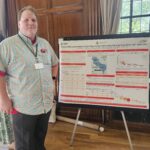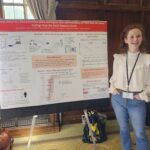SRP staff, trainees, and affiliates are invited speakers, have had posters accepted, or both at the National PFAS Conference in June.

Carolyn Mattingly (Admin Core) – The Comparative Toxicogenomics Database (CTD): A public resource for understanding exposure effects on human health. Exposure to chemicals have been shown to influence most chronic diseases. The Comparative Toxicogenomics Database (CTD; http://ctdbase.org) was released in 2004 to help users understand the effects of diverse chemicals on human health.

David Collier (Project 1) will be a speaker during the Session 2:Guidance for Clinicians on day two. The topic will be PFAS and Health Care Providers in northeastern North Carolina: What Should we Know?”
David also will have a poster- Outlier Analysis: A Case Study Supports Universal PFAS Screening. The GenX Cohort Study, a longitudinal health study exploring PFAS exposure and health outcomes in three communities in North Carolina’s Cape Fear River basin, includes residents living near the Fayetteville Works facility. Here we describe the case of a study participant with several seemingly disparate medical conditions and unusually high serum levels of a variety of PFAS at baseline (2021) and two years later (2023).

Jamie DeWitt (Project 2) will be giving the Keynote Presentation on the last day of the conference.

Detlef Knappe (Project 4) will be a speaker during Session 1: Remediation on the last day of the conference.

Katy May (CEC) will presenting a workshop on Educational Outreach for K-12 Students on PFAS at the end of the conference. Participants in this interactive session will hear from educators and scientists at three NIEHS-funded research centers that feature current research on PFAS in K-12 classrooms and informal science learning environments.

Jeff Yoder (Project 2) will be presenting a poster on Legacy and Emerging per- and polyfluoroalkyl substances (PFASs) suppress the neutrophil respiratory burst.

Danielle Westerman (Project 4) – Atmospheric releases of PFAS during wastewater treatment and implications for worker exposure. During wastewater treatment, particularly during aeration, per- and polyfluoroalkyl substances (PFAS) can be released to air as a result of volatilization and aerosolization. The overarching aim of this research was to evaluate the release of PFAS to the air above aeration basins in wastewater treatment plants by determining PFAS concentration in the aerosol and gas phases.

Michael Cuffney (GenX Exposure Study) – Serum PFAS concentrations from three communities along the Cape Fear River, NC. The GenX Exposure Study started in 2017 to evaluate exposure to GenX and other PFAS in residents of Wilmington, NC, ~90 miles downriver from a fluorochemical manufacturing plant. To follow-up on these findings, the GenX cohort study began in 2020 to evaluate PFAS exposure and health effects throughout the Cape Fear River Basin focusing on three distinct communities: the Lower Cape Fear region including Wilmington; the private well community near the chemical plant in Fayetteville, NC; and the town of Pittsboro, ~100 miles upriver from the chemical plant.

Susie Proctor (GenX Exposure Study) – Homes closer to a fluorochemical plant had higher dust concentrations of PFAS from the plant: findings from the GenX Exposure Study. PFAS in air emissions from a fluorochemical plant in North Carolina led to the contamination of over 10,000 private wells. Apart from well water consumption, residents may also be exposed to PFAS through dust in their homes. To investigate the dust exposure route, we collected dust samples in 2019 from 65 homes located within 6 miles of the plant.
